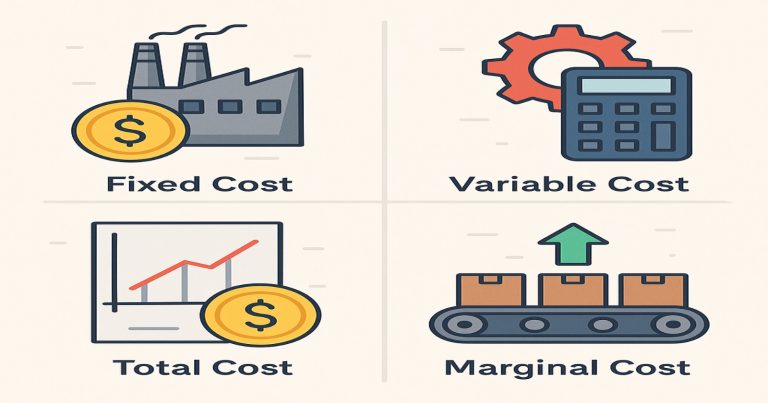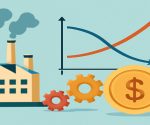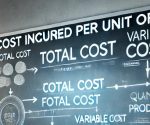Types of Cost of Production refer to the various expenses incurred by firms in the process of producing goods and services. These costs are crucial in understanding a firm’s pricing, profitability, and decision-making. The main objective of cost analysis is to help businesses efficiently allocate resources, control expenses, and maximize profits. In this article, we will explore the different types of production costs, their significance, and how they impact the overall economic performance of firms.
What Are Types of Cost of Production?
Types of Cost of Production encompass all the expenditures that a business incurs to produce goods or services. These costs can be broadly classified into fixed costs, variable costs, and semi-variable costs. Fixed costs remain constant regardless of production levels, while variable costs fluctuate with the volume of production. The understanding of these costs is vital for pricing strategies, profit planning, and assessing the financial viability of a business. Different types of costs allow businesses to allocate resources efficiently, streamline production, and ultimately enhance profitability.
Fixed Costs
Fixed costs are the expenses that do not change with the level of output. Regardless of whether a firm produces one unit or a thousand units, fixed costs remain constant. These costs are incurred even if no production takes place, making them independent of the business’s operational activities.
Key Characteristics of Fixed Costs
- Independence from Output: Fixed costs remain the same regardless of the volume of production.
- Long-Term Nature: These costs are typically associated with long-term expenses, such as the purchase of machinery, rent, and insurance.
- Consistency: Fixed costs do not fluctuate over time (within a given period).
Examples of Fixed Costs
- Rent: Payments made for business premises or factory space.
- Salaries: Wages paid to permanent employees, which are not tied to production volume.
- Depreciation: The loss in value of assets like machinery and equipment, which is accounted for over time.
Importance of Fixed Costs
- Budgeting and Forecasting: Fixed costs help businesses plan their financial needs for the long term.
- Break-Even Analysis: Fixed costs play a critical role in determining the break-even point of a business.
Understanding fixed costs is essential because they help businesses assess how much revenue is needed to cover their basic operating expenses before generating a profit.
Variable Costs
Variable costs are costs that change directly with the level of production. As the output of goods or services increases, variable costs rise proportionally. Conversely, when production slows down, variable costs decrease.
Key Characteristics of Variable Costs
- Dependence on Output: The cost increases as production volume increases, and vice versa.
- Direct Link to Production: These costs are directly tied to production activities.
- Short-Term Nature: Variable costs tend to change in the short run as production decisions are adjusted.
Examples of Variable Costs
- Raw Materials: The cost of materials used in the manufacturing process increases as more products are produced.
- Hourly Wages: Payments made to workers based on the number of hours worked.
- Utilities: Costs for electricity, water, and gas that vary with the level of production.
Importance of Variable Costs
- Cost Control: Variable costs are key to understanding how much a business needs to spend to produce additional units of output.
- Pricing Decisions: Businesses often use variable cost information to set product prices that can cover these costs and yield a profit.
By managing variable costs efficiently, businesses can reduce expenses during slower production periods, making them an essential factor in overall cost management.
Semi-Variable Costs
Semi-variable costs are costs that contain both fixed and variable components. These costs are partially fixed, meaning they don’t change with production within certain limits, but can increase once production exceeds a specific threshold.
Key Characteristics of Semi-Variable Costs
- Combination of Fixed and Variable: Semi-variable costs have both a fixed and a variable element.
- Threshold Level: Costs remain fixed up to a certain level of output, after which they become variable.
- Adjustability: These costs can change depending on production levels, but only after certain conditions are met.
Examples of Semi-Variable Costs
- Telephone Bills: Basic line rent may remain fixed, but additional usage charges depend on the volume of calls made.
- Maintenance Costs: Basic maintenance for machinery may be a fixed cost, but extra maintenance work could incur additional variable costs depending on machine usage.
Importance of Semi-Variable Costs
- Operational Flexibility: Semi-variable costs give businesses flexibility to manage costs during periods of fluctuating production.
- Cost Planning: It is crucial for businesses to forecast and manage semi-variable costs effectively for better profitability.
By identifying and managing semi-variable costs, businesses can more accurately project their operational expenses.
Total Cost of Production
Total cost of production is the sum of fixed, variable, and semi-variable costs incurred in the production process. This total cost is an important indicator for determining the financial viability of a business and helps in pricing, budgeting, and financial planning.
Why Total Cost Matters?
- Profitability Assessment: Total costs are crucial in assessing whether a business can generate enough revenue to cover all its expenses and earn a profit.
- Break-Even Analysis: Total cost is used in calculating the break-even point, which is the production level at which total revenue equals total costs.
Marginal Cost
Marginal cost is the additional cost a business incurs when it produces one more unit of output. It helps managers decide whether increasing production will be profitable or not.
Formula:
Marginal Cost (MC)=Change in Total Cost / Change in Output
Features of Marginal Cost:
- It only considers variable costs, as fixed costs remain unchanged with output.
- It is a short-run concept, meaning it focuses on immediate changes.
- It is used for decision-making, especially when comparing cost with revenue.
The Role of Cost Management in Business
Effective cost management is essential for the long-term success of any business. By understanding the different types of production costs, firms can optimize their operations and improve their bottom line.
Strategies for Managing Costs
- Cost Reduction: Identifying and eliminating waste in production processes.
- Efficient Resource Allocation: Ensuring that resources (labor, materials, equipment) are used in the most productive way.
- Outsourcing: Outsourcing non-core activities to reduce labor and operational costs.
Conclusion
In conclusion, understanding the types of cost of production is fundamental to managing a successful business. Fixed costs, variable costs, and semi-variable costs all play significant roles in determining a firm’s overall cost structure. By analyzing and controlling these costs, businesses can enhance their profitability, optimize production, and improve operational efficiency. Proper cost management is key to making informed business decisions, setting competitive prices, and ensuring financial sustainability.
Types of Cost of Production FAQs
What are fixed costs?
Fixed costs are costs that remain constant regardless of the level of output, such as rent, salaries, and insurance.
What are variable costs?
Variable costs change directly with the level of production. Examples include raw materials, wages based on hours worked, and utility costs.
What is the difference between fixed and variable costs?
Fixed costs do not change with production levels, while variable costs fluctuate depending on the volume of production.
What are semi-variable costs?
Semi-variable costs have both fixed and variable components, such as a basic service charge with additional costs that depend on usage (e.g., phone bills).
Why is cost management important in production?
Cost management helps businesses optimize production, reduce unnecessary expenses, improve profitability, and make informed pricing and operational decisions.


